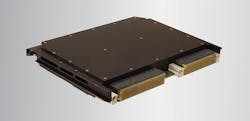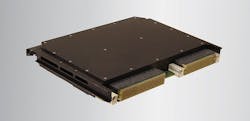Curtiss-Wright debuts rugged dual-GPGPU OpenVPX supercomputing module for radar, SIGINT, EO/IR
ASHBURN, Va., 5 April 2016. Curtiss-Wright’s Defense Solutions division in Ashburn, Virginia, is introducing its second-generation, rugged graphics processing unit (GPU) module for deployed radar, signals intelligence (SIGINT), and electro-optics/infrared (EO/IR) high-performance embedded computing (HPEC) applications.
The new CHAMP-GP3 general-purpose graphics processor unit (GPGPU) Application Accelerator brings the floating-point processing power of NVIDIA’s Maxwell architecture class GPGPUs to the embedded aerospace and defense market in a 6U OpenVPX module, company officials say. The board features dual 1536-core Tesla M6 MXM high-performance computing devices to provide 5 TFLOPS of compute performance in a single slot, officials describe.
The CHAMP-GP3 commercial off-the-shelf (COTS) module provides a size, weight, and power (SWaP)-optimized solution for system designers who seek the supercomputing capability of a Tesla GPGPU to address applications that can’t be satisfied by aggregating multiple microprocessors.
The CHAMP-GP3 is designed for compute-intensive applications that require extreme processing, such as intelligence, surveillance, and reconnaissance (ISR) and electronic warfare (EW) applications that require TFLOPS of accelerated processing. System designers using the CHAMP-GP3 can develop new applications in a fraction of the time required by FPGA-based solutions, thanks to its support for the popular CUDA and OpenCL programming languages, company officials explain. The module is ideal for addressing the massive amounts of data generated by modern radar, SIGINT, and EO/IR sensors and provides unparalleled HPEC performance in cross-cueing applications.
In conjunction, NVIDIA has selected Curtiss-Wright to become a member of its NVIDIA Partner Network program.
“In recent years, we have seen the use of GPUs in ISR and HPEC applications leap from the experimental stage to the implementation stage. These SWaP-sensitive programs are hungry for as much shear processing power as they can fit into a single board slot. With 5 TFLOPS of floating point performance the CHAMP-GP3’s dual Tesla GPGPUs deliver the performance ISR and HPEC customers have been seeking,” says Lynn Bamford, senior vice president and general manager, Defense Solutions division.
Curtiss-Wright’s OpenHPEC Accelerator Suite of software development tools, including Allinea DDT and Allinea MAP, supports Allinea Software’s CUDA profiling and can significantly speed and ease the development of systems using the CHAMP-GP3, officials add.
Curtiss-Wright Corp. delivers highly engineered, critical function products and services to the commercial, industrial, defense, and energy markets. Building on the heritage of Glenn Curtiss and the Wright brothers, Curtiss-Wright has a long tradition of providing solutions through trusted customer relationships. The company employs approximately 8,400 people worldwide.
You might also like:
Subscribe today to receive all the latest aerospace technology and engineering news, delivered directly to your e-mail inbox twice a week (Tuesdays and Thursdays). Sign upfor your free subscription to the Intelligent Inbox e-newsletter at http://www.intelligent-aerospace.com/subscribe.html.
Connect with Intelligent Aerospace on social media: Twitter (@IntelligentAero), LinkedIn,Google+, and Instagram.
Intelligent Aerospace
Global Aerospace Technology NetworkIntelligent Aerospace, the global aerospace technology network, reports on the latest tools, technologies, and trends of vital importance to aerospace professionals involved in air traffic control, airport operations, satellites and space, and commercial and military avionics on fixed-wing, rotor-wing, and unmanned aircraft throughout the world.


